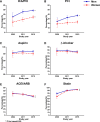Sex Differences in Characteristics, Treatments, and Outcomes Among Patients Hospitalized for Non-ST-Segment-Elevation Myocardial Infarction in China: 2006 to 2015
- PMID: 35607994
- PMCID: PMC9208815
- DOI: 10.1161/CIRCOUTCOMES.121.008535
Sex Differences in Characteristics, Treatments, and Outcomes Among Patients Hospitalized for Non-ST-Segment-Elevation Myocardial Infarction in China: 2006 to 2015
Abstract
Background: Sex differences in clinical characteristics and in-hospital outcomes among patients with non-ST-segment-elevation myocardial infarction have been described in Western countries, but whether these differences exist in China is unknown.
Methods: We used a 2-stage random sampling design to create a nationally representative sample of patients admitted to 151 Chinese hospitals for non-ST-segment-elevation myocardial infarction in 2006, 2011, and 2015 and examined sex differences in clinical profiles, treatments, and in-hospital outcomes over this time. Multivariable logistic regression models adjusting for age or other potentially confounding clinical covariates were used to estimate these sex-specific differences.
Results: Among 4611 patients, the proportion of women (39.8%) was unchanged between 2006 and 2015. Women were older with higher rates of hypertension, diabetes, and dyslipidemia. Among patients without contraindications, women were less likely to receive treatments than men, with significant differences for aspirin in 2015 (90.3% versus 93.9%) and for invasive strategy in 2011 (28.7% versus 45.7%) and 2015 (34.0% versus 48.4%). After adjusting for age, such differences in aspirin and invasive strategy in 2015 were not significant, but the difference in invasive strategy in 2011 persisted. The sex gaps in the use of invasive strategy did not narrow. From 2006 to 2015, a significant decrease in in-hospital mortality was observed in men (from 16.9% to 8.7%), but not in women (from 11.8% to 12.0%), with significant interaction between sex and study year (P=0.023). After adjustment, in-hospital mortality in women was significantly lower than men in 2006, but not in 2011 or 2015.
Conclusions: Sex differences in cardiovascular risk factors and invasive strategy after non-ST-segment-elevation myocardial infarction were observed between 2011 and 2015 in China. Although sex gaps in in-hospital mortality were largely explained by age differences, efforts to narrow sex-related disparities in quality of care should remain a focus.
Registration: URL: http://www.
Clinicaltrials: gov; Unique identifier: NCT01624883.
Keywords: mortality; myocardial infarction; quality of health care; risk factors; sex characteristics; women.
Figures


References
-
- Blomkalns AL, Chen AY, Hochman JS, Peterson ED, Trynosky K, Diercks DB, Brogan GX, Jr, Boden WE, Roe MT, Ohman EM, et al. ; CRUSADE Investigators. Gender disparities in the diagnosis and treatment of non-ST-segment elevation acute coronary syndromes: large-scale observations from the CRUSADE (Can Rapid Risk Stratification of Unstable Angina Patients Suppress Adverse Outcomes With Early Implementation of the American College of Cardiology/American Heart Association Guidelines) National Quality Improvement Initiative. J Am Coll Cardiol. 2005;45:832–837. doi: 10.1016/j.jacc.2004.11.055 - PubMed
-
- Heer T, Gitt AK, Juenger C, Schiele R, Wienbergen H, Towae F, Gottwitz M, Zahn R, Zeymer U, Senges J; ACOS Investigators. Gender differences in acute non-ST-segment elevation myocardial infarction. Am J Cardiol. 2006;98:160–166. doi: 10.1016/j.amjcard.2006.01.072 - PubMed
-
- Bassand JP, Hamm CW, Ardissino D, Boersma E, Budaj A, Fernández-Avilés F, Fox KA, Hasdai D, Ohman EM, Wallentin L, et al. . Guidelines for the diagnosis and treatment of non-ST-segment elevation acute coronary syndromes. Eur Heart J. 2007;28:1598–1660. doi: 10.1093/eurheartj/ehm161 - PubMed
-
- Anderson JL, Adams CD, Antman EM, Bridges CR, Califf RM, Casey DE, Jr, Chavey WE, 2nd, Fesmire FM, Hochman JS, Levin TN, et al. ; American College of Cardiology; American Heart Association Task Force on Practice Guidelines (Writing Committee to Revise the 2002 Guidelines for the Management of Patients With Unstable Angina/Non-ST-Elevation Myocardial Infarction); American College of Emergency Physicians; Society for Cardiovascular Angiography and Interventions; Society of Thoracic Surgeons; American Association of Cardiovascular and Pulmonary Rehabilitation; Society for Academic Emergency Medicine. ACC/AHA 2007 guidelines for the management of patients with unstable angina/non-ST-Elevation myocardial infarction: a report of the American College of Cardiology/American Heart Association Task Force on Practice Guidelines (Writing Committee to Revise the 2002 Guidelines for the Management of Patients With Unstable Angina/Non-ST-Elevation Myocardial Infarction) developed in collaboration with the American College of Emergency Physicians, the Society for Cardiovascular Angiography and Interventions, and the Society of Thoracic Surgeons endorsed by the American Association of Cardiovascular and Pulmonary Rehabilitation and the Society for Academic Emergency Medicine. J Am Coll Cardiol. 2007;50:e1–e157. doi: 10.1016/j.jacc.2007.02.013 - PubMed
-
- Yeh RW, Sidney S, Chandra M, Sorel M, Selby JV, Go AS. Population trends in the incidence and outcomes of acute myocardial infarction. N Engl J Med. 2010;362:2155–2165. doi: 10.1056/NEJMoa0908610 - PubMed
Publication types
MeSH terms
Substances
Associated data
Grants and funding
LinkOut - more resources
Full Text Sources
Medical

